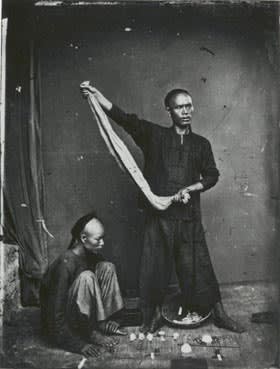John Thomson (1837-1931), one of the great figures of nineteenth century photography, is known for the unusual and exotic nature of his chosen subject matter. Born in Edinburgh, Scotland in 1837, Thomson took up photography as a profession in his early twenties. For ten years, from 1862, he traveled and explored the Far East, visiting Hong Kong, Singapore, Penang and the Malay Peninsula, Siam, Cambodia, Vietnam, Formosa and especially China.
Utilizing a large wooden box-type camera capable of accommodating a glass plate of up to 12 x 16 inches, John Thomson photographed commoners and kings, attempting to capture the individual behind the veneer of social status. His photographic record of the Far East documented a complete panorama of the cultures and people of the Far East at a time when Westerners were a few and curious lot. John Thomson not only created a photographic history, but also wrote numerous articles and books on his travels and views of life in the Far East.
Thomson's negatives survive largely intact and his glass plate negatives have been used to create new printing negatives to help preserve his work for years to come. All photographs are silver gelatin prints, printed using Thomson's original negatives. In many cases, due to the fact that Thomson did not have a notebook and pen with him at all times, he made notes on the backs of his negatives to remind him of locations or names of subjects. When printed, these notes print in reverse and are clearly inscribed on a number of images. In addition to these marks, other marks of age and some crop marks have been retained to preserve the character of the original negatives, and in most cases the full negative has been printed, without cropping borders.






